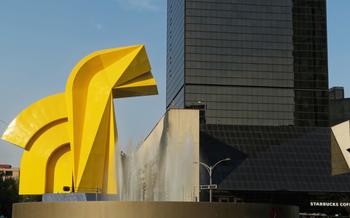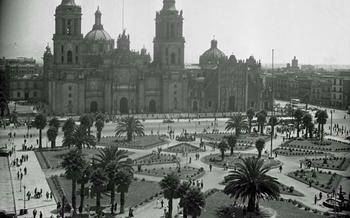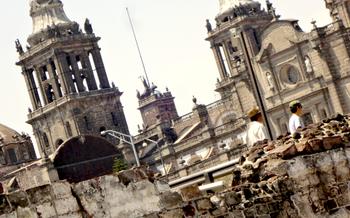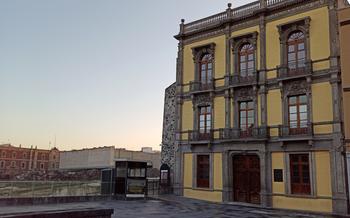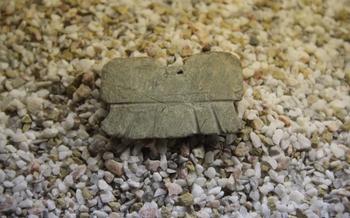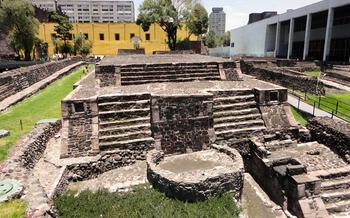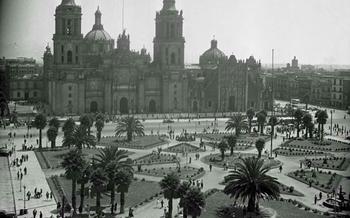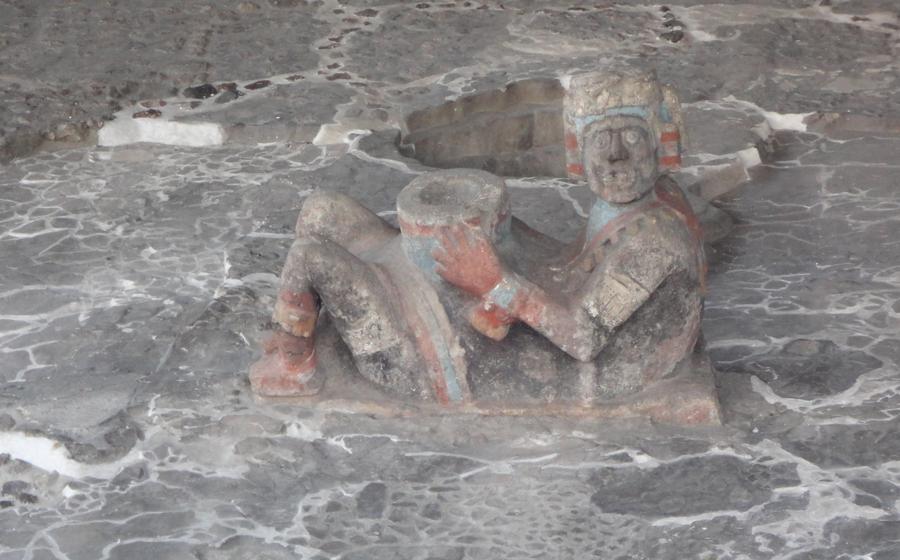
Templo Mayor
- History and significance of the Templo Mayor
- Stepping into the Past: Exploring the Templo Mayor Museum
- Witnessing the Power of Religion: The Templo Mayor's Ceremonies
- Uncovering the Secrets of the Great Pyramid
- Paying Homage at the Altar of Tlaloc
- Marveling at the Templo Mayor's Sculptures and Reliefs
- Unearthing the Ancient Ball Court: Juego de Pelota
- Respecting Local Customs and Traditions
- Insider Tip: Uncovering Hidden Gems
History and significance of the Templo Mayor
Deep in the heart of Mexico City, where the bustling modern metropolis meets the echoes of ancient civilizations, lies the Templo Mayor, a testament to the grandeur and spiritual beliefs of the once-mighty Aztec Empire. Built in the 14th century, this awe-inspiring pyramid temple complex served as the religious and political center of Tenochtitlan, the Aztec capital. Dedicated to the Aztec gods Huitzilopochtli, the patron deity of war and the sun, and Tlaloc, the god of rain and water, the Templo Mayor was not just a place of worship but also a symbol of power and prestige. Its imposing structure, intricate carvings, and elaborate rituals offer a glimpse into the rich cultural heritage of the Aztecs and their profound connection to the divine.
Stepping into the Past: Exploring the Templo Mayor Museum
Beyond the impressive ruins and ancient structures, the Templo Mayor Museum offers a captivating journey into the heart of Aztec culture. Inside its modern and interactive exhibits, visitors are transported back in time, immersed in the vibrant world of the ancient Aztecs. Through state-of-the-art displays and multimedia presentations, the museum brings to life the grandeur and complexity of this once-mighty civilization.
Artifacts unearthed during excavations are showcased, providing tangible evidence of Aztec craftsmanship, artistry, and religious beliefs. Visitors can marvel at intricately carved stone sculptures, pottery vessels adorned with symbolic designs, and precious ornaments that once adorned Aztec royalty. These artifacts offer a glimpse into the daily lives, rituals, and beliefs of the Aztec people, shedding light on their sophisticated culture and rich history.
The museum's interactive exhibits engage visitors of all ages, allowing them to explore Aztec culture through hands-on experiences. Visitors can learn about the Aztec calendar system, decipher ancient glyphs, and even try their hand at traditional Aztec games. Through these interactive displays, the museum creates a vibrant and immersive learning environment, making the history and legacy of the Aztecs accessible and engaging to visitors from around the world.
Witnessing the Power of Religion: The Templo Mayor's Ceremonies
In the heart of the Aztec Empire, the Templo Mayor was not just a sacred structure but a stage for elaborate religious rituals and ceremonies that formed the core of Aztec society. These ceremonies were intricate performances that showcased the power, devotion, and beliefs of the Aztec people.
Reenactments and performances of these ancient ceremonies bring to life the grandeur and symbolism that surrounded them. Visitors can witness the enactment of rituals such as the "New Fire Ceremony," where priests ignited a new fire to mark the beginning of a new 52-year cycle, or the "Feast of Toxcatl," which celebrated the god of spring and fertility.
Through these performances, visitors gain a deeper understanding of the role of priests, who held immense power and influence in Aztec society. They also witness the significance of sacrifices, which were believed to appease the gods and ensure the continued prosperity of the empire. Offerings of precious objects, animals, and even human lives were made to honor the deities and seek their favor.
The ceremonies at the Templo Mayor were not just religious spectacles but also powerful displays of devotion, awe, and the deep connection between the Aztecs and their gods. They offer a glimpse into the spiritual heart of an ancient civilization and the profound reverence they held for their beliefs.
Uncovering the Secrets of the Great Pyramid
Amidst the sprawling ruins of the Templo Mayor, the Great Pyramid stands tall, embodying the architectural prowess and spiritual significance of the ancient Aztecs. This colossal structure formed the heart of the city of Tenochtitlan, serving as a sacred site for religious ceremonies and a symbol of the Aztec Empire's power.
The pyramid's intricate construction techniques showcase the ingenuity of Aztec engineers. Built without the use of wheels or metal tools, it stands as a testament to their remarkable engineering skills. Every stone was carefully shaped and fitted together, forming a massive structure that has withstood the test of time.
The Great Pyramid held immense symbolic value, representing the sacred mountain and the axis mundi, the center of the universe. Its four sides were aligned with the cardinal directions, connecting the earthly realm with the heavens. The pyramid's summit featured two temples, one dedicated to the Aztec war god Huitzilopochtli, and the other to the rain god Tlaloc, reflecting the Aztecs' deep reverence for both warfare and agriculture.
Visitors to the Templo Mayor can climb the pyramid's steep steps, taking in the panoramic views of the city and the surrounding landscape. This vantage point offers a unique perspective, allowing visitors to appreciate the scale and majesty of this ancient architectural marvel, a symbol of the Aztec civilization's enduring legacy.
Paying Homage at the Altar of Tlaloc
Amidst Tlaloc, dedicated to the revered rain god. Tlaloc's significance in Aztec culture cannot be overstated, as water and agriculture were the lifeblood of their civilization. The impressive Tlaloc monolith, carved from a single block of basalt, stands as a testament to the Aztecs' devotion to this deity. Its intricate carvings depict Tlaloc's distinctive features, including his goggle-like eyes and prominent fangs.
Offerings and rituals played a crucial role in appeasing Tlaloc and ensuring his benevolence. The Aztecs believed that by presenting him with gifts, they could secure his favor and prevent droughts or floods. These offerings often included precious objects, such as jade, turquoise, and gold, as well as food and drink. During ceremonies, priests would perform elaborate rituals, invoking Tlaloc's power and seeking his blessings for abundant rainfall.
The Altar of Tlaloc serves as a poignant reminder of the deep connection between the Aztecs and their gods. It invites visitors to delve into the beliefs and practices of this ancient civilization, shedding light on their reverence for nature and their reliance on divine intervention for sustenance and prosperity.
Marveling at the Templo Mayor's Sculptures and Reliefs
The Templo Mayor is a treasure trove of exquisite stone carvings and intricate designs. These sculptures and reliefs adorn the temple's walls, staircases, and altars, creating a visually stunning and deeply symbolic narrative. Master artisans crafted these masterpieces using a variety of techniques, including carving, sculpting, and molding, showcasing their exceptional skill and artistry.
The sculptures and reliefs depict a wide range of subjects, including deities, mythical creatures, historical events, and scenes from everyday Aztec life. Each piece holds profound symbolic meaning, reflecting the Aztecs' religious beliefs, cultural values, and historical achievements. They serve as windows into the past, allowing us to glimpse the rich tapestry of Aztec art and culture.
One of the most striking sculptures is the colossal head of the rain god Tlaloc, which weighs several tons and is adorned with elaborate headdresses and ornaments. The head symbolizes Tlaloc's power over water and fertility, essential elements for the survival of the Aztec civilization.
Another highlight is the relief known as the "Stone of Tizoc," which depicts the Aztec ruler Tizoc performing a ritual sacrifice. The intricate carvings showcase the Aztecs' sophisticated understanding of anatomy and their emphasis on the importance of human sacrifice in their religious practices.
These sculptures and reliefs are not merely decorative elements; they played a vital role in Aztec religious ceremonies. They served as representations of the gods, allowing the Aztecs to interact with and honor their deities. The reliefs also functioned as historical records, commemorating important events and achievements of the Aztec Empire.
By studying these sculptures and reliefs, we gain valuable insights into the Aztec worldview, their artistic prowess, and the profound significance of their religious beliefs. They stand as testaments to the ingenuity and creativity of the Aztec civilization, leaving a lasting legacy that continues to inspire and fascinate visitors from around the world.
Unearthing the Ancient Ball Court: Juego de Pelota
Amidst the sacred precinct of the Templo Mayor, lies a fascinating vestige of Aztec culture – the ancient ball court, known as the Juego de Pelota. This unique sporting arena holds immense significance in understanding the religious, social, and political aspects of Aztec society.
The ball game, played with a solid rubber ball, was more than just a mere pastime; it was a ritualistic and competitive event deeply intertwined with Aztec mythology and religious beliefs. The court, with its sloped sides and stone markers, served as a stage for this sacred game, where players engaged in intense matches that often carried symbolic and divinatory meanings.
Beyond its sporting function, the Juego de Pelota held profound cultural and religious implications. It was believed that the outcome of the game could influence the fate of the Aztec Empire and its people. The players, often adorned in elaborate costumes, represented deities or mythical figures, and the game itself was seen as a reenactment of cosmic battles between gods.
The Templo Mayor's ball court stands as a testament to the Aztec's mastery of architecture and engineering. Its construction involved precise alignments and intricate stonework, demonstrating the advanced skills of Aztec builders. The court's dimensions and acoustics were carefully designed to create an immersive and awe-inspiring atmosphere during matches.
Today, visitors to the Templo Mayor can explore the ancient ball court and marvel at its well-preserved features. The court provides a glimpse into the vibrant and complex world of Aztec culture, showcasing their ingenuity, athleticism, and deep-rooted spiritual beliefs.
Respecting Local Customs and Traditions
When visiting the Templo Mayor, it is essential to remember that it holds deep cultural and religious significance for local communities. Observing proper etiquette and dress code is essential to show respect and avoid causing offense. Appropriate attire includes modest clothing that covers shoulders and knees, as revealing outfits may be considered disrespectful in this sacred space.
Interacting with local vendors and guides should be done with politeness and respect. Engaging in conversations and learning about their experiences and perspectives can provide valuable insights into the Templo Mayor's history and cultural significance. Supporting sustainable tourism practices by choosing local guides and tour operators who prioritize responsible tourism practices is also crucial.
By respecting local customs and traditions, visitors can contribute to preserving and celebrating the rich cultural heritage associated with the Templo Mayor while fostering positive interactions with the local community.
Insider Tip: Uncovering Hidden Gems
Beyond the Templo Mayor, Mexico City offers a wealth of hidden gems that will further immerse you in the city's rich history and culture. Just a short walk away, discover the Templo de Ehécatl, dedicated to the wind god, with its unique circular design and intricate carvings. For a deeper understanding of Mesoamerican history and culture, visit the renowned Museo Nacional de Antropología, housing an impressive collection of artifacts and exhibits. Don't miss the chance to stroll through the historic center of Mexico City, a UNESCO World Heritage Site, and admire its colonial architecture, vibrant markets, and hidden plazas, offering a glimpse into the city's rich past.
